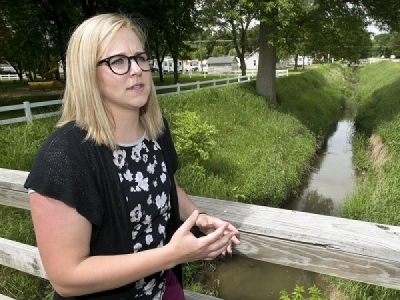
Posted on June 7, 2018
By Nick Hytrek, Sioux City Journal
Complaining about government rules and regulations probably ranks near the top of many Americans’ favorite pastimes.
Many of our friends and neighbors argue that it would be a lot easier to run a business or own a home if there was less government red tape.
For years, Randolph residents have made that argument about flood-related regulations.
Middle Logan Creek cuts through town from west to east, placing much of Randolph in a federally designated flood plain. The designation requires many residents to carry costly flood insurance. Other regulations affect construction of new buildings or renovations to existing ones.
“It restricts our development possibilities, whether it’s residential or business,” said city administrator Kelsey Backer, echoing the belief that the flood regulations have discouraged residential and commercial development over the years.
That’s about to change, residents here hope.
In May, Randolph voters by a 158-to-44 margin passed a 1.5-cent sales tax increase needed to ensure funding for a $13 million-$14 million project to widen and deepen approximately one mile of the creek through town and remove 131 of 137 structures from the flood plain, thus eliminating many of those government regulations.
It’s a huge development for a town that’s currently riding a wave of momentum to bring new families and businesses — and thus new life — to Randolph.
“This is a very exciting time for us,” Backer said. “It’s the closest the city has ever been to finalizing this project. The dream of reducing the flood risk in the city is finally becoming close to reality.”
Backer said the creek has flooded 14 times in the past 100 years. State and federal regulations place additional requirements and regulations on new construction and renovations or additions to existing buildings within the flood plain. Some of those rules raise construction costs to a point, Backer said, that many believe it’s not worth it to build there.
“It’s hard for people to develop on those properties,” she said.
Beginning in 2001, the city has explored how to get removed from the flood plain. Momentum picked up in recent years, and the city had gotten commitments of $8.52 million from the U.S. Army Corps of Engineers, $1.97 million from the Lower Elkhorn Natural Resources District, $120,000 from Cedar County and $75,000 from Pierce County to fund the channel work and replacement of five of six bridges that currently span the creek in town.
The final piece needed was a $2.76 million U.S. Department of Agriculture loan. The loan was contingent upon the passage of the sales tax increase, which will be used to pay off the loan. Soon after the sales tax measure passed, the USDA announced the loan, and city residents knew for sure that the flood plain regulations would soon be water under the bridge.
“They are relieved that an end is in sight,” Backer said.
With funding in place, she said, the Corps of Engineers can proceed to the final design phase. It’s hoped that construction will begin next year. Work will take two years because the bridge replacements, necessary to span the wider channel, must be staggered so as not to cut off one side of the town from the other.
The channel project will add to the recent list of accomplishments in town. In January, the Cardinal Kids Learning Center, licensed to provide day care and preschool for 75 children age 6 weeks to 5 years old, opened, helping alleviate a day care shortage and provide kids with an educational boost heading into kindergarten while creating a few new jobs at the same time.
A renovation of the city’s auditorium also was recently completed, upgrading the facility, which hosts wedding receptions and other celebrations that bring people into town. It’s hoped that the improvements might attract more events, leading to increased sales tax revenue.
Added to the creek widening project, those developments and others being floated by community members are aimed at drawing young families and new businesses to town.
“Our hope is that our town will continue to grow,” Backer said. “We have a lot of community members that are really motivated right now and they’re bringing their ideas forward.”
A flood of new ideas sounds better any day than old complaints about government regulations.
Source: Sioux City





